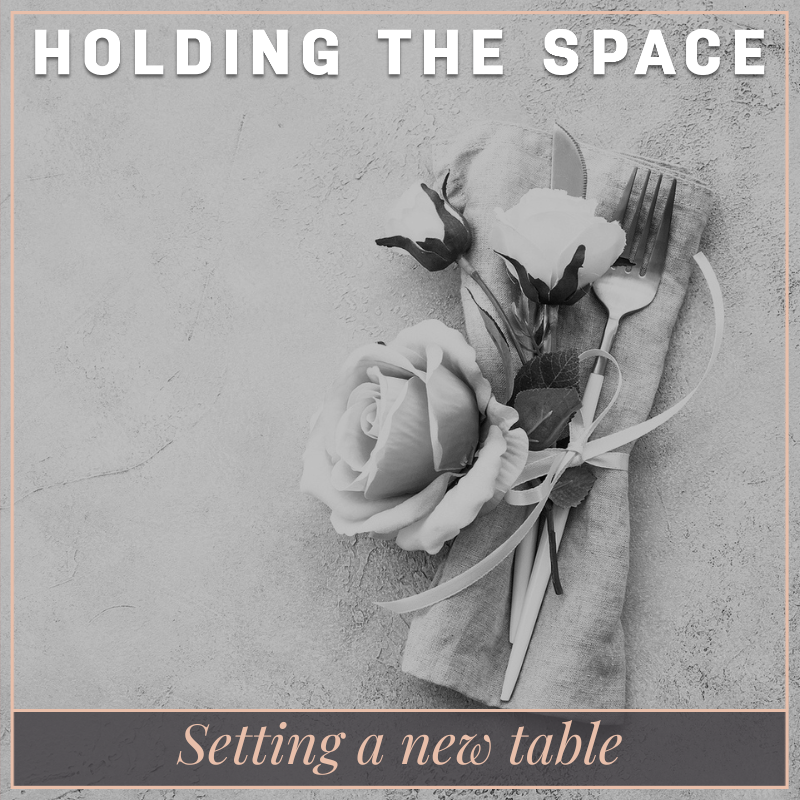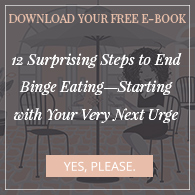
Setting a new table

This time of year, Ramadan, Passover, and Easter are celebrations that honor what we believe, who we are, and who we love. There are open hearts and open homes. Whether it’s sharing a tradition, a meal, or a hunt, there are many opportunities to nourish ourselves and our relationships.
The promise of renewal is everywhere. And so is food.
It could be at a meal or waiting for it, holidays like these can be both beautiful and challenging. If this sounds like you, you’re not alone.
When I was younger, Easter was so exciting. I couldn’t wait for us to get together with my grandparents, aunts, uncles, and cousins at the farm. I loved the people, the smells, the colors, and—of course—the chocolate. But as a binge eater, the Easter Bunny and I had a complicated relationship.
Sometimes, I’d just found my stride again after Christmas, New Year’s, Valentine’s (yes, even when I was single), and St. Patty’s Day. Yes, I’m part Irish. I’d just be starting to feel good about myself again, like maybe I could figure this eating thing out after all. I’d be bingeing a bit less often and on a bit less food. I was maybe even feeling a little proud of myself.
Then, out of nowhere, I’d see it. The Easter Bunny. I’d freeze. All I could think of was the three-month nerve-wracking ride just to get here, barely standing. And Big Ears, here, could take it all away.
It wasn’t just the bunny-shaped chocolates that got to me. It was the fear of bingeing on all the treats I knew would be around, the fear of losing control again, of being unable to stop myself from eating almost everything in sight.
It’s like I’d half-run, half-drag my way into Easter. Once there, I’d swoon with the food. Granny made everything astoundingly delicious. I couldn’t get enough.
I’d think about food when we were eating and I’d think about food when we weren’t. There was no escape—even when the food wasn’t right in front of me. And, then, in those moments, I realized I was back. Back in the prison I’d resolved to bust out of on January 1. And as that door slammed shut yet again, there I sat with both guilt and shame.
“I did something wrong,” said Guilt. “I am wrong,” said Shame. Now that was a One-Two Bunny Punch. No wonder I feared the Easter Bunny. And no wonder I loved him.
What I didn’t know then was that those conflicting feelings came from conflicting parts of me. A part of me that craved the chocolate and what it would give me. A part of me hated the chocolate and what it would take away. There was also a part that judged me and the one who held the shame. A grating current of dissonance ran throughout the spring holiday and on into the days that followed.
It was like being on a haunted teeter-totter that never really landed. Always up in the air, hovering, dangling, at the whim of wind and weight. Always at the edge of a descent orchestrated by the other side. It made sense that I felt ungrounded around food—and that I longed to feel my feet touch dirt more than anything else in the world.
If my experience then was anything like yours is now, and you’re wondering how to avoid bingeing over Easter, Passover, or Ramadan, here’s my seven-step process to help you:
- Notice your parts
- Let your parts know you’re there
- Select a part to get to know
- Invite curiosity in
- Connect with your part
- Love on your part
- Set a new table
Let’s go through them together.
7-step process to help you with your eating over the spring holidays
1. Notice your parts
When you feel an urge to binge, turn inside and sense which parts of you are present.
Maybe there’s a part of you that’s overwhelmed by all the holiday preparations and needed to soothe with sweets.
Maybe there’s a part of you that gets scared when it’s forbidden to eat certain foods or to eat at certain times.
Maybe there’s a part of you that feels rebellious and wants to break holiday food rules or non-holiday diets.
Maybe there’s a part of you that criticizes you for bingeing to try to protect you from feeling guilty or ashamed.
Whatever is there is okay.
2. Let your parts know you’re there
Let your parts know that you notice them.
If they’ve been trying to get your attention, acknowledging them can help them settle.
3. Select a part to get to know
Pick a part to connect with. Maybe it’s the one who seems to need your help most right now. Or maybe it’s the one you’re most curious about in the moment.
If you’re open to being curious about the others too, let them know that you’ll be coming back to get to know them also as soon as you can.
4. Invite curiosity in
Take a moment to open your heart as much as you can, so that you can be curious, or at least genuinely interested in getting to know this part.
Try to ease any agendas here. This is just about getting to know the parts of you that are struggling right now.
I know this can be hard if you can sense multiple parts vying for your attention. But let your parts know that if you can be with one part even for a while, it will likely help them too. And remind them that you want to hear from them also, but need to listen to one part at a time.
5. Connect with your part
Check inside and sense where you experience the part you’ve chosen to focus on in or around your body.
In that place or in those places, what physical sensations are there? For example, is it heavy in your heart? Or is it skittish in your belly?
Ask the part what it wants you to know. What does it want or need from you right now? For example, does it want you to promise not to be so mean to it if it can’t help but eat right now? Does it want you to know how scared it gets around so many people?
Listen with as much curiosity as you can. From this place, is what your part’s sharing making sense to you, even a little?
If so, let your part know that you’re getting what it’s sharing with you.
If it doesn’t make sense to you yet, let your part know that you’re learning how to be open to it so you can understand it better in time.
Ask your part what it’s like for it to have you understand it or, at least, be open to trying to understand it?
Be patient and wait for it to respond.
What does it say? Does it’s response make sense to you too?
Do you notice any shift in your body where you’ve been sensing this part? Often parts soften a little when they know they’re not alone.
6. Love on your part
If you’re feeling inclined to judge the part you’ve been getting to know, notice that that’s another part in you that’s upset with this one. Ask it to give you some space to keep connecting with the part you’ve been curious about. As counter-intuitive as this may seem, no part ever means to get in the way.
Each part of us carries its own unique experience and story. Each one tries to help us in the best way it knows how, even if we don’t understand everything about that right now.
If you can appreciate that this part has been trying to help, a little of that love will go a long way to helping it relax and let you in a little bit more to understand how you can help and offer healing.
7. Set a new table
Invite other parts to the table and continue this process with them.
One by one, as you help your parts, you may feel a deepening sense of internal harmony as well as expanding space for you to make clearer choices about what you eat, when, and for what reasons.
Although your parts may disagree on what exactly is the best way to help you, they’re all on your side. They will come to realize this in time as they sit together at your beautiful family banquet, with you at the head, inviting the sharing around the table.
When you notice your parts and get to know them, they begin to soften from their rigidly held beliefs. And, when they do, they make room for you to lead your system.
So here again is my seven-step process to help you stop bingeing over Easter, Passover, or Ramadan, or any time you feel conflicted about food.
- Notice your parts
- Let your parts know you’re there
- Select a part to get to know
- Invite curiosity in
- Connect with your part
- Love on your part
- Set a new table
With tenacity, compassion, and openness to explore different parts of yourself—your internal family—you can learn to find balance during the holidays.
Internal Family Systems, the trauma-informed, evidence-based approach founded by Dr Richard Schwartz, can help us communicate with our different parts, so we can find a way to balance our emotional and physical needs, to attune to the dissonance and bring it into harmony.
In time, you parts can become an incredible advisory committee seated right there at the table before you.
Oh—and before I sign off—just a note: I may not be the Easter Bunny, but I’ve got a few treats for you. If you’re interested in private coaching with me, click here and get on my calendar for a complementary consult today.
Do you have anything you want me write about that would help you with your eating? Please send me your questions, ideas, and reflections!
Recovering from binge eating can be so much easier with a guide by your side. Interested in private coaching with a Master Coach who's Level-3 trained in the evidence-based, SAMHSA-recognized Internal Family Systems approach? If the answer is yes, then get on my schedule for a free, 30-minute consultation! You'll be so glad you did!




Previous Article
Making it outNext Article